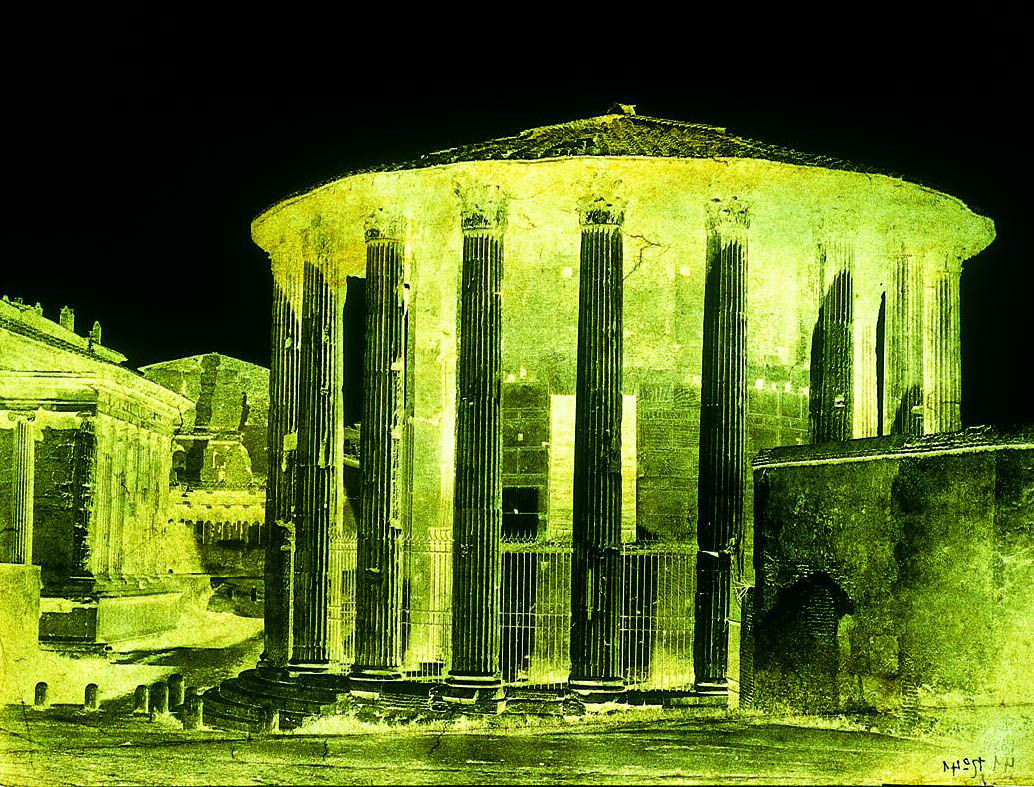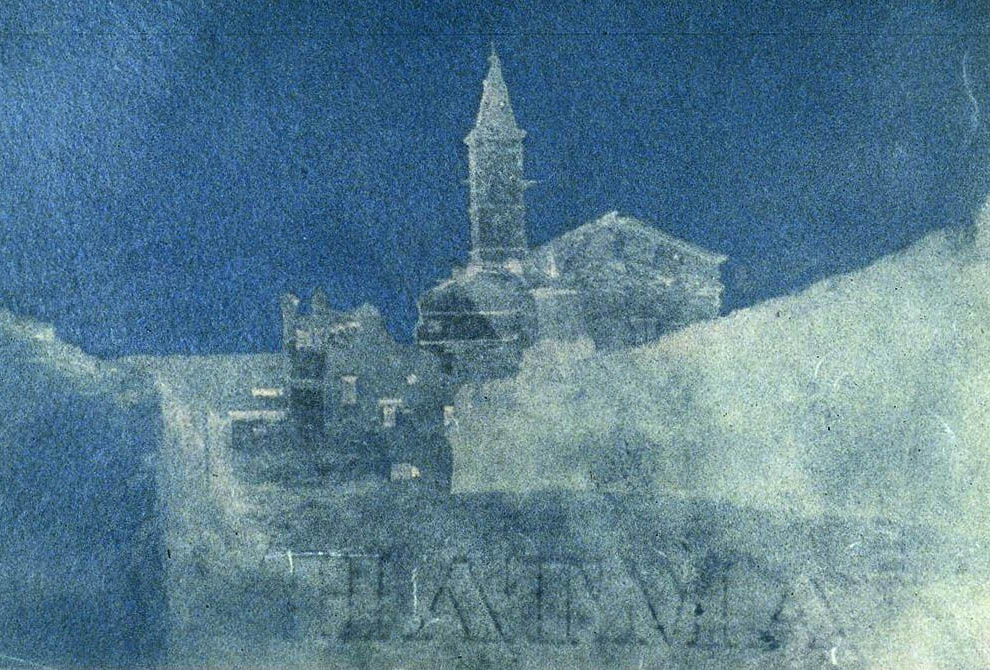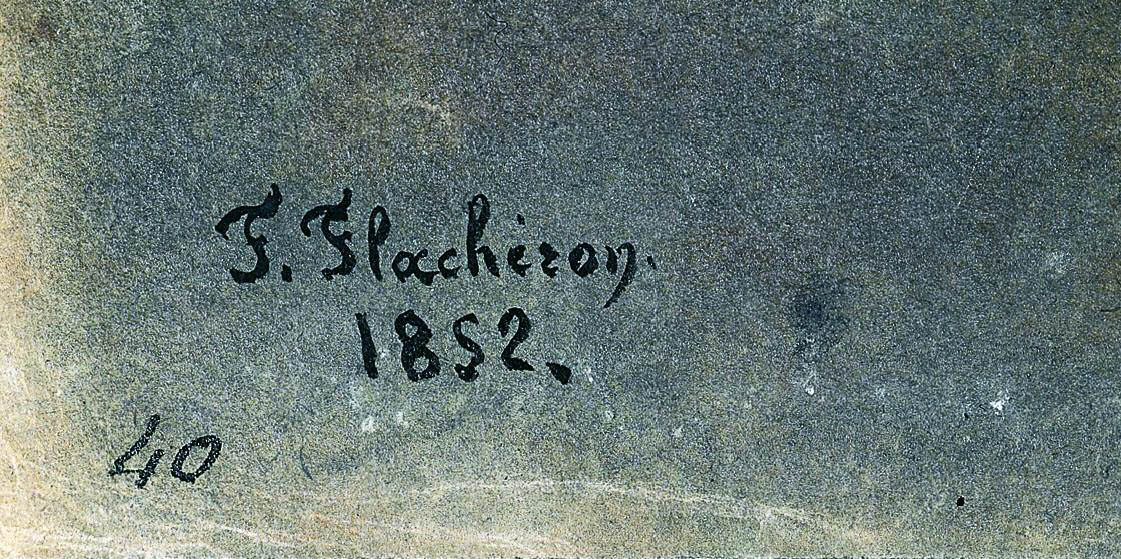“A TRANSPARENT ATMOSPHERE”: THE PAPER NEGATIVES OF FR�D�RIC FLACH�RON IN THE HARRISON D. HORBLIT COLLECTIONLEE ANN DAFFNER
1 INTRODUCTIONThe examination and analysis of the Fr�d�ric Flach�ron paper negatives were initiated to advance our understanding of these important 19th-century photographic artifacts while addressing the preservation needs of all 364 paper negatives in the Harrison D. Horblit Collection of Early Photography. The project, completed in 1998, was one facet in a year-long Conservation Treatment Grant jointly sponsored by the Getty Grant Program and the Department of Printing and Graphic Arts in Houghton Library of Harvard University. Flach�ron, who trained at the French Academy of Art, transferred traditional art materials and techniques to photography. These material components were the focus of a technical investigation, including Fourier transform infrared (FTIR) spectroscopy and gas chromatography. The preservation and stabilization of this collection included an item-level examination, creation of a database to record the survey findings, photographic documentation, design and fabrication of a paper negative rehousing system, and guidelines for the care and handling of these fragile artifacts. 1.1 FR�D�RIC FLACH�RONJean-Fran�oise-Charles-Andr� Flach�ron, Count Fr�d�ric Flach�ron, was born in 1813 in Lyons, France, to an extensive artistic family, one of numerous children of Louis Flach�ron, the town architect. Fr�d�ric and his brother Isidore both studied under notable artists of the day: Fr�d�ric with the sculptor and medalist Pierre-Jean David D'Angers (1788–1856), and Isidore with the painter Jean-Auguste-Dominique Ingres (1780–1867). In 1839 Flach�ron won the second Grand Prix de Rome and moved to the “Eternal City.” There he met Caroline Hayard (fig. 1), proprietress of a shop selling artist's supplies on the Piazza di Spagna (Rouillac 1987). The two married in 1842 (Helsted 1978). Caroline, born in 1810, grew up among artists such as Ingres, who was director of the French Academy of Rome at the time and an intimate friend of the Hayard family. The Flach�rons had three children and lived in Rome until 1867 when they moved to Paris, where they stayed for the remainder of their lives (Naef 1966, 1977). The Hayard shop and the Flach�ron home were located near the historic Caf� Gr�co, a well-known and important meeting place for artistic circles (fig. 2).
Between 1848 and 1853, perhaps catalyzed by his training in sculpture and his father's architecture, Flach�ron systematically photographed the great structures and views of Rome and environs with a paper negative process (fig. 3, see page 446). It is not certain where or from whom Flach�ron learned photography, but by February 1849 he was producing such astonishing prints that his works were eagerly being collected by members of his circle. “Flach�ron has made some masterpieces lately. They
The details of Flach�ron's arrangement with his print dealers have not been fully researched. In 1852 three individuals in London—Antoine Claudet, a photographer; Mark Anthony, an artist; and Hippolyte Bailli�re, a publisher of French medical books—owned his prints. These three loaned prints from their collections to the first large-scale photographic exhibition held in Britain. This exhibition was hosted by the Society of Arts, London, and it opened to widespread acclaim at the society's premises in December 1852. The following year, 1853, Flach�ron's prints were being sold through the Photographic Institution, Bond Street, London, a venture established by Joseph Cundall and Philip Delamotte. The relatively high price of Flach�ron's prints, at 15 shillings each, places them at the high end of the market when compared to the work of other photographers represented by the Photographic Institution (Taylor 2002). 1.2 FLACH�RON'S PAPER NEGATIVE PROCESSRare and delicate, the paper negative was the first means by which photographers could make multiple positive prints. One-hundred and fifty-five negatives by Flach�ron are known to exist; 37 are now in the Horblit Collection. Flach�ron's circle used a process first publicly described by Louis-D�sir� Blanquart-Evrard to the Paris Academy of Sciences in January 1847, which is a variant of Henry Talbot's calotype process (Talbot 1841). It came to be known as either the Roman method or as the wet paper process. “The work of Fr�d�ric Flach�ron, who works by a modification of the Roman Process,” reported the Art Journal, “possesses many beauties, mainly due to the transparent atmosphere in which he operates” (Art Journal 1853, 56). The process begins by choosing a high-quality, smooth, wove paper (fig. 4, see page 446). In Flach�ron's case, 10 of the 37 negatives studied showed full or partial Whatman paper watermarks, and all were found to measure .003 in. (76.2 microns) when measured with a Starrett no. 223 paper micrometer caliper. (For comparison, a page from the JAIC journal measures on the average .004 in. or 101.6 microns).
Photographic Notes reported:
The negatives fall neatly into two size formats: the small negatives measure 7 � 8� in. (17.78 � 21.59 cm), while the large format dimensions are, on the average, 10 � 14 in. (25.4 � 35.56 cm). According to the published accounts of Flach�ron's method, the paper is cut to size and coated with a salting solution of potassium iodide. The paper can be stored indefinitely at this stage. To complete the sensitization, the iodized paper is placed face down on the glass of the negative holder previously coated with a solution of silver nitrate and acetic acid. It is kept damp by several layers of moist backing paper. A final sheet of glass completes the package, which is placed into the negative holder and into the camera for exposure while the negative is still damp (Thomas 1852). This wet procedure kept the light-sensitive chemistry in a humid, reactive atmosphere and ready for the day's photographic excursions. Paper negative photographers of the 1850s could modify their photographic processes when traveling in hot, southern climates where unexposed, sensitized negative papers would easily spoil. In addition to the damp paper, there was a second modification that rendered the wet paper process particularly well suited to use in warm weather. This was the addition of potassium bromide to a salting solution composed primarily of potassium iodide, first used by Antoine Gaudin in 1841 (Gaudin 1841). In a simplified explanation of the photochemistry, of the three silver halides, silver iodide reacts the most rapidly to light;
Three published reports of Flach�ron's process relate similar procedures, materials, and chemical solutions (Thomas 1852; Photographic Notes 1856; American Journal of Photography 1865). After a four–six minute exposure in the camera, the negative is ready for development. The latent image is amplified in a developing solution of saturated gallic acid for approximately 20 minutes. In this reaction, the developing agent (gallic acid) donates electrons to the silver ions present so that metallic silver is catalytically produced on the surface of the latent image. As this coating or plating of the latent image continues, the particles physically enlarge, and consequently the image grows to a visible size, resulting in a neutral, gray image, consistent with a form of development known as physical development (Haist 1979). Interestingly, the developed image was stabilized in a solution of potassium bromide before being fixed with sodium thiosulphite (Thomas 1852). Given the overall uniformity of the negatives, the consistency of papers, and the high quality of images produced with exceptional detail, it can be concluded that Flach�ron probably used the same process for all the paper negatives examined in the Horblit Collection. To prepare the negatives for printing, all 37 Flach�ron negatives were evenly saturated with wax to increase transparency. In addition, Flach�ron used two methods of retouching. In the first, powdered graphite was rubbed into the paper surface to increase the opacity of various areas, which would result in subtle gradations (see figs. 4, 5, page 446). This technique can be seen in the work of Benjamen Brecknell Turner at the Royal Photographic Society in Bath, England, and by Victor Prevost at the George Eastman House in Rochester, New York. For stronger effects, usually to the sky, a black opaquing medium such as heavy gouache was applied (fig. 6, see page 446). Both methods of retouching would yield corresponding lighter areas in the positive print. Flach�ron signed and dated most of his negatives with gouache, black ink, or graphite pencil. These inscriptions appear on the topmost surface of the paper negative, that is, on top of the waxed surface, ranging in date from 1849 to 1853 (fig. 7, see page 447).
|






